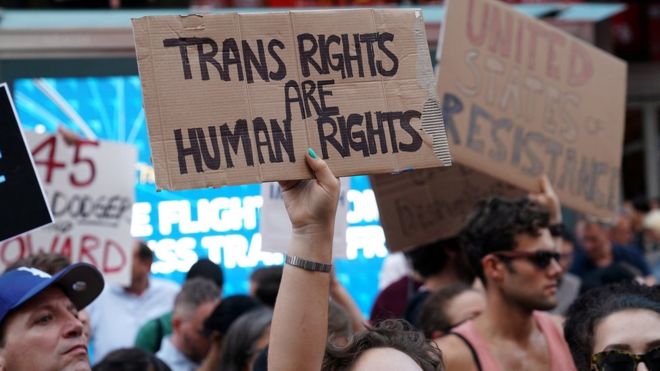Supreme Court Allows Transgender Ban


People protest after President Trump’s statement on Twitter. Courtesy of BBC.com
By Rachel Stevens
This past Tuesday the Supreme Court allowed President Donald Trump’s proposed transgender military ban to go into effect. The vote in the Supreme Court on the issue at hand was 5-4. In July 2017, President Trump first proposed the ban on transgender individuals in the military through a tweet.
“After consultation with my Generals and military experts, please be advised that the United States Government will not accept or allow Transgender individuals to serve in any capacity in the U.S. Military,” Trump tweeted. “Our military must be focused on decisive and overwhelming victory and cannot be burdened with the tremendous medical costs and disruption that transgender in the military would entail.”
A transgender individual is someone who is formally diagnosed with a condition known as gender dysphoria. Gender dysphoria is defined by the American Psychiatric Association as involving “a conflict between a person’s physical or assigned gender and the gender with which he/she/they identify.” People with gender dysphoria may be very uncomfortable with the gender they were assigned, sometimes described as being uncomfortable with their body (particularly developments during puberty) or being uncomfortable with the expected roles of their assigned gender.
Most transgender individuals can no longer serve, but there are some exceptions. Those who have been stable (have completed hormone treatments and surgeries) for three years in their biological sex prior to joining the military, service members diagnosed with gender dysphoria after joining the military service, members who were diagnosed with gender dysphoria before the effective date of the policy, and transgender persons without a gender dysphoria diagnosis or history are all still allowed to serve in the U.S. military. By the government’s own numbers in 2016, there were approximately 8,980 service members that identify as transgender.
Reactions to this ban on Capitol Hill are predictably mixed. Some say that this ban will improve military performance, while others discredit the ban to nothing more than discriminatory action against the LGBT community. Speaker of the House Nancy Pelosi tweeted that the ban is, “purpose-built to humiliate brave men & women seeking to serve their country.” On the other side, a former Texas land commissioner, state senator and retired Marine Vietnam veteran Jerry Patterson, said that, “The premise that ‘individual rights’ or ‘equal opportunity’ matter in this debate is bogus. No one has a right to serve in the military.” There is a clear and extreme divide between opinion on this policy and there will undoubtedly be further debate on the implications of the policy.
Here at Catholic University reactions are also mixed. Sophomore CUAllies member Q Garcia-Geary made a statement in which they described their feelings towards the new policy.
“As a transgender person, this Supreme Court ruling hit me extremely hard. The Trump administration has continuously attempted to erase and demonize the transgender community.— It is obvious that this ban has little to do with saving money, or making the military more efficient. The purpose of the ban is to further confuse the general public on what it means to be transgender, further alienate, and further demonize the transgender community. Being trans has no effect on one’s readiness and ability to serve one’s country. “
The affirmative side of the argument states that it would be inappropriate use of funds to pay for treatments of transgender individuals and that they are not ready and able to be in combat. The opposed states that it is discrimination and that a transgender individual has the same abilities of combat as any other military personnel. No matter which side, one thing is evident: people are interested to see the implications of this policy moving forward in the military.







